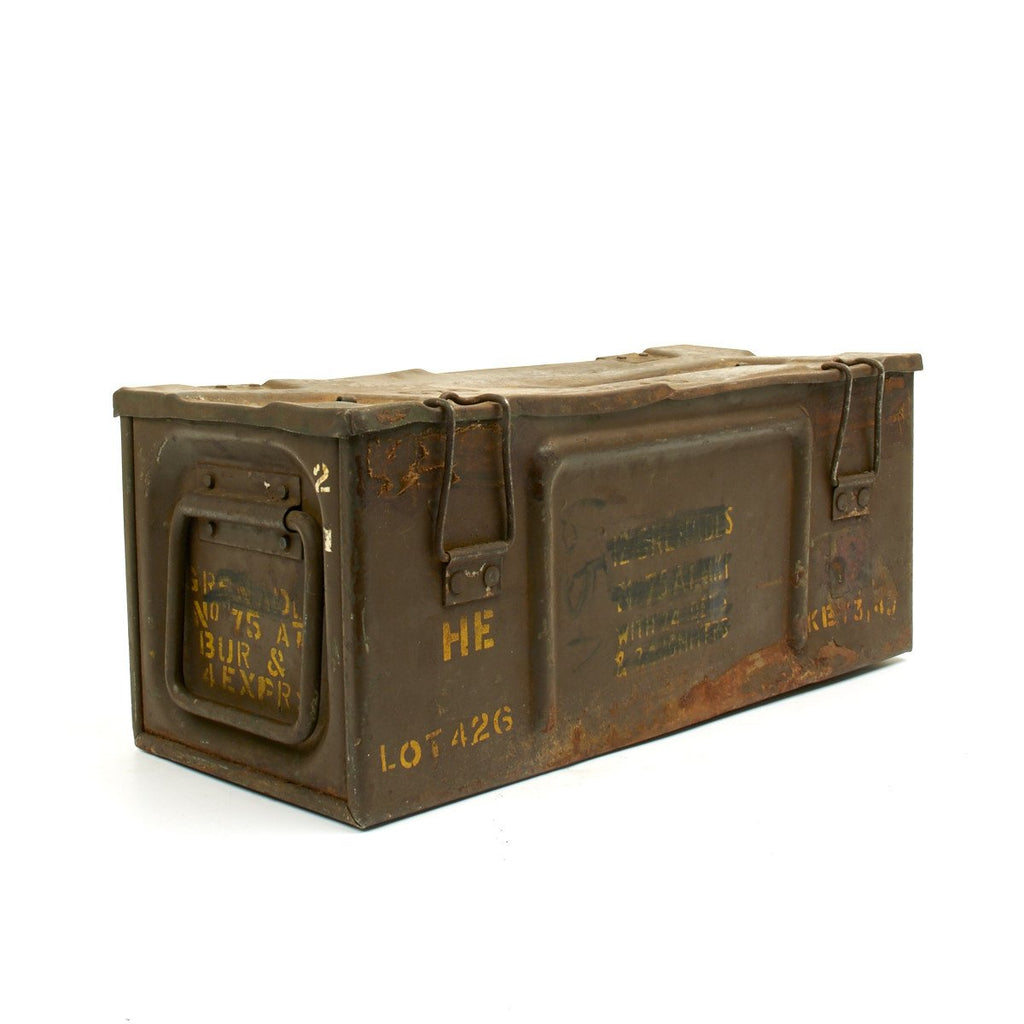Item Description
Original Item: Very few available. These are WWII dated G70 ordnance steel transport ammunition boxes for 12 Grenade, Hand, Anti-tank, No. 75, also known as the Hawkins grenades.
Approximate measurements are 19.25 L x 8.5 W x 8.5 D.
Each box has G170 I with wartime date stamped into the steel top and shows stenciling on the side that reads:
No. 75
The Grenade, Hand, Anti-tank, No. 75, also known as the Hawkins grenade was a British anti-tank hand grenade used during World War II. It was one of a number of grenades developed for use by the British Army and Home Guard in the aftermath of the Dunkirk evacuation. The grenade first appeared in 1942, and was designed to be more versatile than previous grenades, such as the Grenade, Hand, Anti-tank No. 73 and the Grenade, Hand, Anti-Tank, No. 74.
It was rectangular in shape, about 150 millimetres (5.9 in) in length and 75 millimetres (3.0 in) in width, and contained approximately 0.45 kilograms (0.99 lb) of explosive. When a vehicle drove over the grenade, it cracked a chemical igniter and leaked acid onto a sensitive chemical, which detonated the explosive. Multiple grenades were often used to destroy tanks or disable their tracks, and the grenade could also be used as a demolition charge.
Development
With the end of the Battle of France and the evacuation of the British Expeditionary Force from the port of Dunkirk between 26 May and 4 June 1940, a German invasion of Great Britain seemed likely. However, the British Army was not well-equipped to defend the country in such an event; in the weeks after the Dunkirk evacuation it could only field twenty-seven divisions. The Army was particularly short of anti-tank guns, 840 of which had been left behind in France and only 167 were available in Britain; ammunition was so scarce for the remaining guns that regulations forbade even a single round being used for training purposes.
As a result of these shortcomings, a number of new anti-tank weapons had to be developed to equip the British Army and the Home Guard with the means to repel German armoured vehicles. Many of these were anti-tank hand grenades, large numbers of which could be built in a very short space of time and for a low cost. They included the Grenade, Hand, Anti-tank No. 73, which was little more than a Thermos-sized bottle filled with TNT, and the Grenade, Hand, Anti-tank No. 74, also known as the 'Sticky bomb', which was coated with a strong adhesive and 'stuck' to a vehicle. A more versatile grenade appeared in 1942 in the form of the Grenade, Hand, Anti-tank, No. 75, more commonly known as the Hawkins grenade, which was designed so that it could be used in a number of roles.
Design
The grenade was rectangular in shape and approximately 150 millimeters (5.9 in) in length and 75 millimeters (3.0 in) in width, and weighed about 1.02 kilograms (2.2 lb). Its explosive content consisted of around 0.45 kilograms (0.99 lb) of blasting explosive, which was usually either ammonal or TNT. On the top of the grenade was a plate, under which the user would insert a chemical igniter, which would act as the weapon's fuse. When a vehicle drove over the grenade, its weight crushed the plate, which in turn cracked the igniter; this then leaked acid onto a sensitive chemical which detonated the charge. The grenade was designed so that it could either be thrown at a vehicle like an ordinary anti-tank grenade, or placed at a location when used as an anti-tank mine. It was also fitted with areas where blasting caps or cordtex could be placed, so that it could be used as a demolition charge. When the grenade was used, it was recommended that the user be within a short distance of their target, ideally concealed within a trench; if the target were an armored vehicle, then the best areas to target were the sides and rear, where the engine compartment was located and armor was generally thinner.
Operational history
Introduced in 1942, the grenade saw service with the British Army until 1955. The United States Army also used the grenade, as well as developing their own variant, known as the M7 light anti-tank mine. When used in an anti-tank role, a number of the grenades could be strung together in a 'daisy chain' at intervals of around two feet, and then placed across a road to damage an armored vehicle. It was particularly effective at damaging the tracks of a tank. When sufficient grenades were grouped together, they were capable of disabling a medium tank. The Hawkins was also used in other roles, such as breaching walls, and its small size also meant that it could easily be placed into the 'web' of a railway line and, when detonated, destroy a section of track.
- This product is available for international shipping.
- Not eligible for payment with Paypal or Amazon
































